A Chef’s Masterclass — Ben Spalding of Roganic
A look behind the pass, as a chef from a top restaurant serves some of his dishes.

The other day I went to a chef’s masterclass given by Ben Spalding of Roganic. Ben is rapidly making a name for himself, with his focus on seasonal and local high quality ingredients, cooked with creativity but not flashiness. Roganic is a two-year popup owned by Simon Rogan, famous for L’Enclume in the Lake District. It was recently awarded three AA rosettes. Both restaurants are at the top of my dream list to eat at — so when I saw a tweet by Ben that he’d be giving this masterclass, I booked straight away.
The evening was hosted at the Divertimenti cookery school, and took the form of Ben and his team preparing the dishes in front of us, telling us about the ingredients and any techniques they’d used for advanced preparation of the food — and then serving it up for us to devour. The important disclaimer is that he was just working within the confines of this demo kitchen, so plating is more ‘rustic’ than at the restaurant.
Canapes
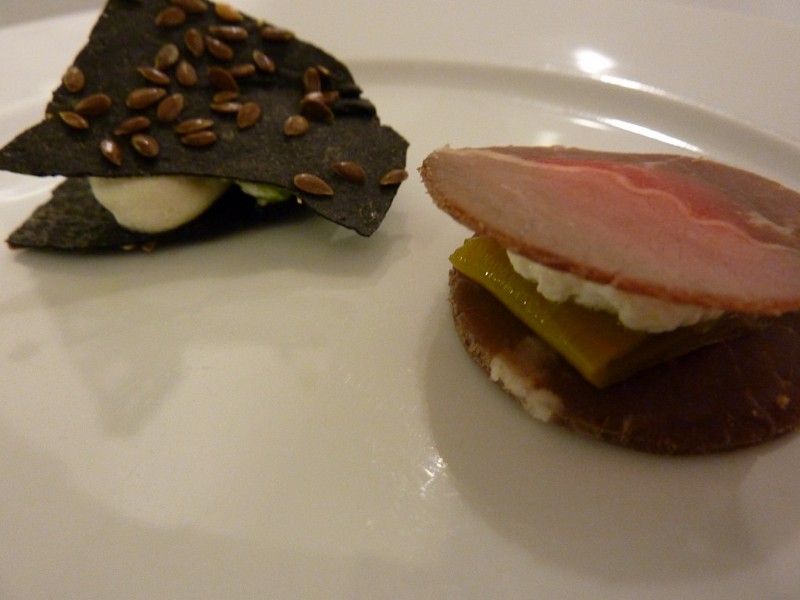
First up were the canapés. On the left are crackers with cream cheese and Alexander leaves (a plant that’s popular with foragers, the leaves taste somewhere between celery and parsley). On the right is the House Cured Beef with Horseradish. The beef was made from a relatively new cut that’s increasingly popular with chefs — the featherblade. This cut is generally cooked very very slowly, but Ben decided to see how it would work when cured. He rubbed it generously in salt, and then smoked it lightly with fir. Then he wrapped it in Muslin and hung it in the fridge for 6 months. The result is delicious — flavoursome and melting.
Next he served up another little appetiser — a shallow fried potato ball dusted in smoked paprika, before we got onto the main dishes.
Baked Dill Omelette with Cauliflower Custard, Shrimps and Lingonberries
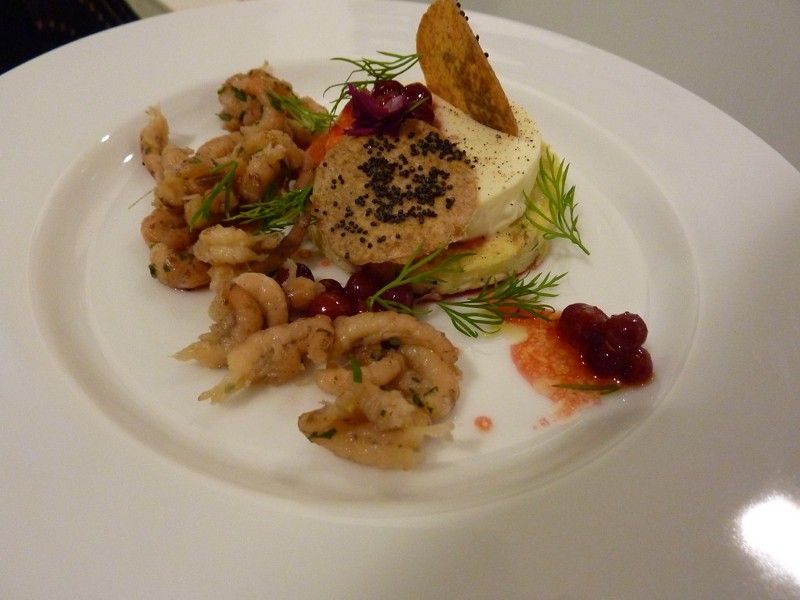
The starter was a Baked Dill Omelette with Cauliflower Custard, Shrimps and Lingonberries. To make the omelette he used (duck, I think) egg yolks (30g), double cream (150g), quality cheddar (40g), some sweated shallots and garlic, dill leaves, butter and some seasoning. He whisked this up and then baked in a small deep oven tray at 135 degrees for about 20 minutes until it was just set, with a wobble. He then set this aside to cool.
For the cauliflower custard (which was set a little like pannacotta) he’d made some cauliflower puree by cooking the cauliflower quickly on a high heat and then pureeing it. He warmed up some milk (50g), and added gelatine (1 leaf, presoaked in cold water) and some salt.
Mackerel Cured in Seawater with Broccoli Cream, Pickled Shallots and Warm Flower Honey
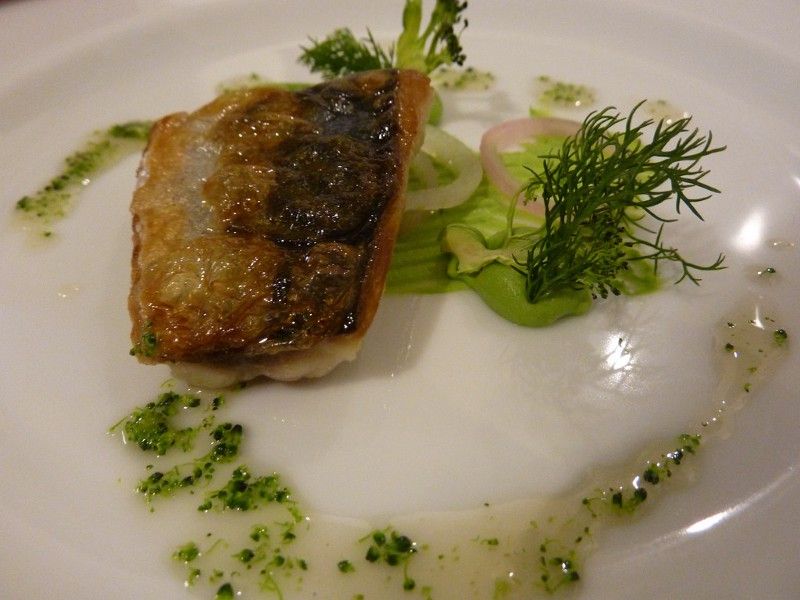
He’d cured the mackerel by first laying the fillets in a tray, skin side down, and sprinkling sugar evenly over them, chilling for 40 minutes. Meanwhile he’d heated 1.5 litres of seawater (that he collects in a bucket from the beach near his home on the South Kent coast, and brings to London on the train!) to 80 degrees Celsius, then allowed it to cool to 25 degrees (checking with a thermometer) and put it through a Brita water filter. At this point he dipped the mackerel into a bowl of fresh water to rinse the sugar off, and laid the fillets in a small deep tray, skin side up — before pouring the seawater over them. He’d then put this in the fridge for 40 minutes to cure. After that he’d removed the fillets, dried them, and stored in the fridge until needed.
If you don’t have the time to wade out for a bucket of actual seawater, then a suitable mix is 1 litre of water to 500g of sea salt.
The little bonsai-tree-like decorations are dried broccoli. For that he sliced broccoli very thinly on a Mandolin, and then dried the slices in a professional drying oven. This is apparently about the size of a microwave, and just has a warm heat to gently dry food, such as fruits or tomatoes — but Ben likes experimenting with it, and says it’s one of his favourite kitchen tools. In the home you could use an oven on a very gentle heat, or a ‘hostess’ trolley left on overnight! Once you want to experiment more with this technique, Ben particularly recommends trying dried strawberries.
For the broccoli cream he cuts the green parts off the broccoli from 2 heads, and puts in boiling salted water for 2 minutes until only just tender. He then cools them quickly in iced water. He fries a diced shallot and a chopped garlic clove until just lightly coloured, then adds 200g of double cream. He reduces this to a third of the quantity, then adds the broccoli, before blending to a smooth mix and seasoning as necessary.
Finally, he pickles the shallot rings. He puts 300g water, 200g white wine vinegar, 100g caster sugar, a bay leaf and 5 black peppercorns into a pan, brings to the boil and takes off the heat. He then slices a shallot and pushes the middle out so he is left with the two outer rings from each slice. He then drops them into the pickling liquid for 20 seconds.
Finally he briefly pan fries the mackerel.
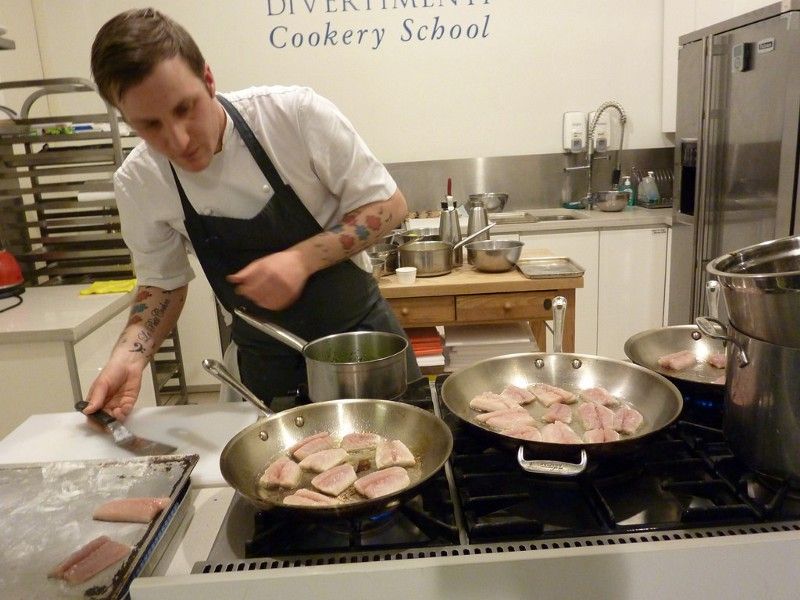
With each fillet he gently scrapes the skin, which ensures excess moisture is removed so it goes nice and cripsy, then he places it skin down in the pan, holding it down so it doesn’t curl. When it’s ready he gives it a brief flip onto the flesh side, before lifting out onto a clean cloth to remove any excess fat.
All the elements of the dish are then arranged on the plate as shown, with a drizzle of the hot honey sauce. This is honey, mixed with a little raspberry vinegar and a little salt and warmed to 60 degrees before allowing to cool. Ben recommends some Regent’s Park honey, or an elderflower honey which he gets from ‘La Fromagerie’.
Poached and Grilled King Oyster, Beetroot and Mushroom ‘soil’
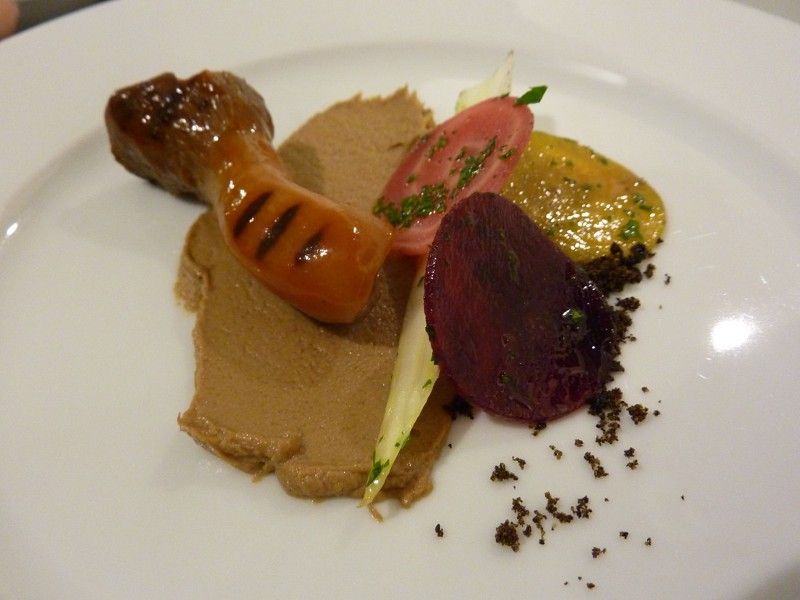
For this dish, Ben wanted to create earthy flavours, and a meaty feel without using meat. He has a specialist mushroom supplier in Norfolk who provides him with a wide variety of unusual funghi, and the King Oyster is one of these. If you can’t get hold of them, any meaty posh mushroom will do. He first poaches them in vegetable stock, along with rosemary, thyme, bay leaf, peppercorns and a little salt — simmering for about 30 minutes. These can then cool and be set aside until needed later — so you can prepare them in advance.
The mushroom puree is made by heating a wide pan to smoking point, adding some rapeseed oil, and then 500g quartered button mushrooms, a sliced shallot, and a garlic clove. Keep stirring to ensure it doesn’t burn, and roast until they get a good colour. Then add 200g salted butter and let it foam, reducing the heat to let the mix fry in the foaming butter for a while, until dark golden. Then strain through a colander to remove the fat. Now return them to the pan with some white wine and allow the wine to reduce to almost nothing before adding 300g vegetable stock. Reduce this by half, add 60g of double cream. Reduce until the mushrooms are completely coated in cream and then blend for 3–5 minutes until smooth, and then press through a fine sieve.
For the mushroom ‘soil’, blend 250g of button mushrooms for about 30 seconds. Then add 25g ground almonds, 3g of salt and 5g icing sugar — and 20g of Douglas fir needles! Then spread onto a piece of parchment paper on a tray and dry in an oven at 60 degrees for 6 hours, or overnight, until it’s completely dried and rock hard. Blend small portions of the mix in a spice grinder to a fine powder that looks like soil.
Finally, slice the beetroots thinly on a mandolin, and cut discs out with a small round pastry cutter. Toss in a light vinaigrette made with 100g cider vinegar, 50g honey, 450g rapeseed oil and a little salt to taste.
Now, all the components are ready and it was time for Ben to grill the mushrooms…
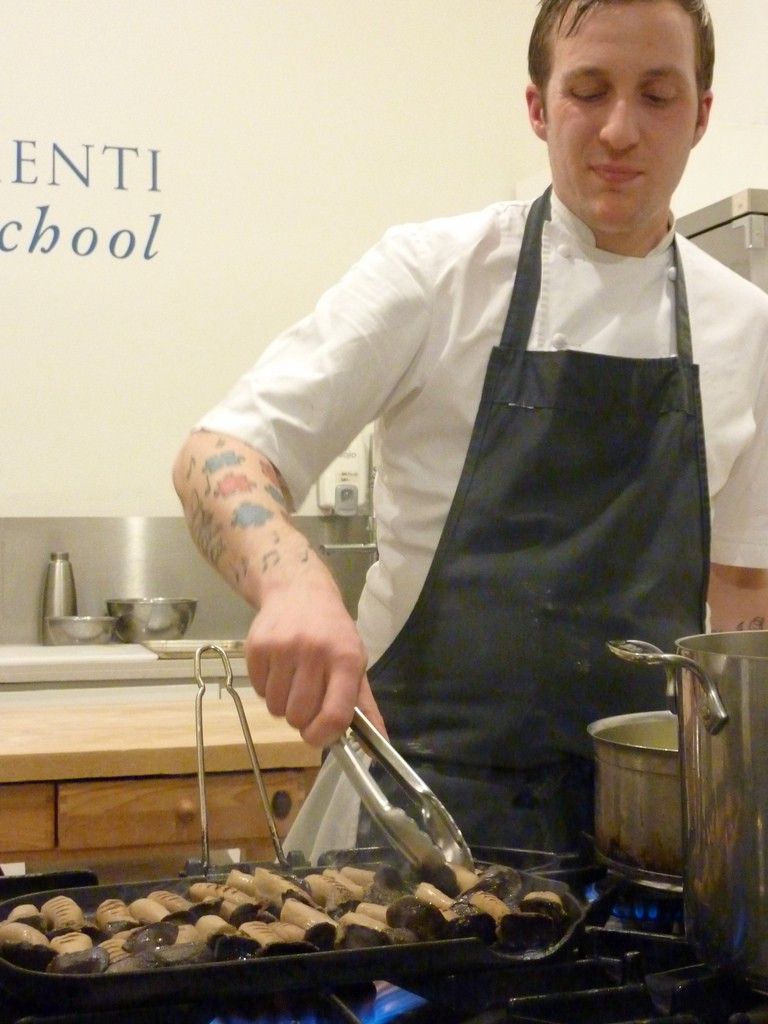
This was done on a hot griddle pan with no oil. When they were done he tossed them in what he calls his ‘umami sauce’, for which he shared his secret recipe…
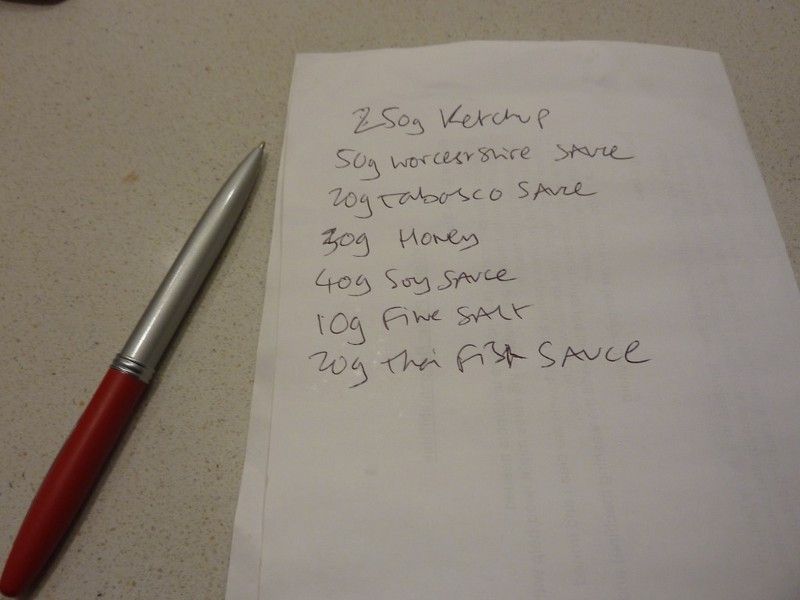
He then drained the mushrooms so there was only a thin coating of this sauce, and plated the dish up as shown above.
Warm Salted Chocolate, Iced Blackberry and Granny Smith Steeped in Mulled Wine
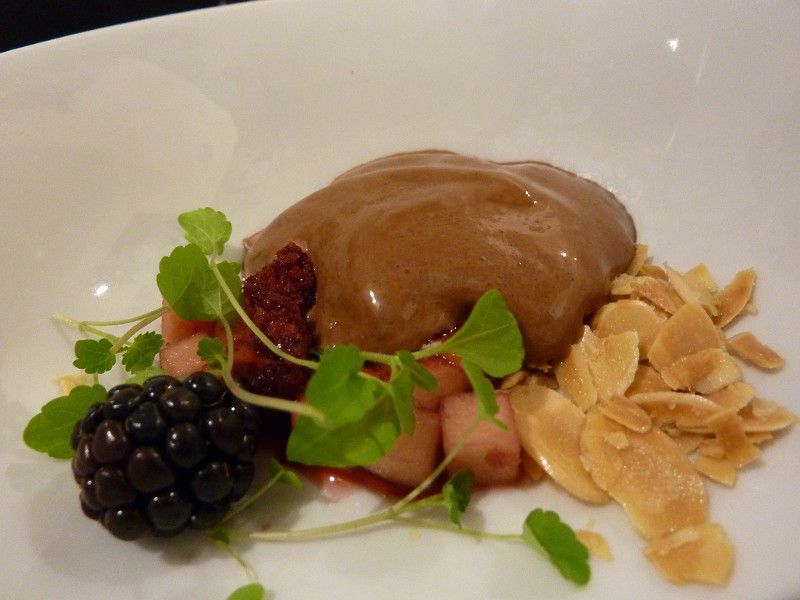
Finally, the dessert that had everyone salivating.
Ben had made a saucepan of mulled wine with 250g red wine, 350g port, 400g caster sugar, the zest and juice of an orange and a lemon, half a bay leaf, 10 black peppercorns, 5 juniper berries, 3 sprigs of rosemary, a cinnamon stick and 100g of Alexander seeds. Then, just before plating, he dropped 3 finely diced granny smith apples into the mix, for a very short time, just to blanche them.
He’d also pre-made some iced blackberries by juicing 2 punnets of the fruit, heating 1/3rd of the juice and whisking in 50g of caster sugar to dissolve it. Then he added the remaining juice and poured it into a plastic container and put it in the freezer. Just before plating he took this out and forked through the ice to break it up.
The salted chocolate was what got everyone excited though, and Ben made it by slowly melting 500g of good quality milk chocolate in a bowl over a pan of slowly simmering water. He warmed 100g of full fat milk and 500g of double cream in a pan until it reached 80 degrees. He then poured this over the chocolate and whisked to mix it well. He has also soaked 5 leaves of gelatin and added this to the mix. He passed it through a fine strainer, and added 8g of good quality sea salt.
He then put 600g of this chocolate mix into a large cream whipper, and charged it twice with CO2 chargers. This mix can be prepared a little in advance and then the whipper can be kept in a pan of hot water at around 60 degrees, but no more than 70 degrees.
Finally, everything was ready and he could plate up with a garnish of toasted almonds, a blackberry, and a few leaves of anise hyssop.
There’s no doubt it was a satisfying evening for the taste buds, but I also found it highly satisfying for my home-cook’s brain. There are lots of tips and ideas that I’m going to use…
I’ll be trying to dry all sorts of ingredients to see what happens. I’ll use that brief pickling technique from the shallot rings. I’ll try curing fish in salt water, and dry-curing beef in the fridge. I’ll be briefly blanching fruit in alcohol for desserts. And I’ve got to find a cream whipper and have some fun experimenting with that! More broadly I’ll be taking away the idea that a great dish can be made by taking the same ingredients in slightly different directions on the same plate — 3 different riffs with mushroom on the oyster mushroom dish, or 2 approaches with broccoli on the mackerel dish.
And Ben seemed like a great chef in all the right ways. Passionate, but still with an insatiable curiosity. He said during the evening that he takes inspiration from lots of places but is still working towards finding ‘his’ style. I think it’s going to be very interesting to follow that journey from tables at Roganic, to wherever his culinary journey takes him after that. Now, I just need to find a special occasion and go to Roganic for the ten-course menu.
Originally published at www.steveparks.co.uk.